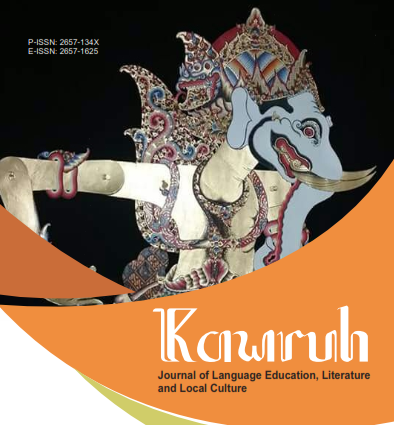Innovation of Aksawa Scrapbook Learning Media to Learn Javanese Script for Elementary School Students
DOI:
https://doi.org/10.32585/kawruh.v6i2.5600Abstract
Javanese language is a compulsory local content in schools from primary to secondary level in Central Java, East Java and Yogyakarta. However, Javanese language lessons, especially Javanese script material for some children, are considered difficult. Based on the results of a survey conducted in several elementary schools in Central Java and Yogyakarta, it is known that almost 90% of students have difficulty reading and writing using Javanese characters. Based on these problems, this research is intended to provide an alternative solution through the development of learning media in the form of Aksawa Scrapbook so that students are more motivated to learn Javanese script. This study uses a research and development (R&D) design with the ADDIE model which consists of analysis, design, development, Implementation, and Evaluation stages. The subjects in this study are students and teachers of elementary schools in Central Java and Yogyakarta. The media feasibility assessment was validated by material experts and media expert validators, as well as classroom teacher practitioners as well as Javanese language teachers. The data collection technique uses observation, interviews and questionnaires. Data analysis techniques use qualitative and quantitative data analysis. The results of this research resulted in a product, namely in the form of Aksawa Scrapbook media. Based on the assessment of experts, practitioners and student responses, the Aksawa Scrapbook media can be declared very feasible to be used for Javanese script learning media in elementary school with an average score of 92.41 with very good criteria. The conclusion of this study is that the script scrapbook media is declared feasible and effective to be used to help students learn Javanese reading and writing skills.
Downloads
References
Al Masjid, A., & Arief, A. (2016). Penggunaan multimedia interaktif untuk meningkatkan kemampuan membaca aksara Jawa pada siswa kelas 5 SD Negeri Blimbing 4. TRIHAYU: Jurnal Pendidikan Ke-SD-An, 3(1).
Amalina, A. F. (2020). Pengembangan Media Scrapbook Dengan Penerapan Pendekatan Kontekstual Pada Muatan Pelajaran Ipa Kelas V Sekolah Dasar. ., 1(5), 468–478.
Cholifah, T. N., & Fauziah, W. N. (2021). Pengembangan media scrapbook pada pembelajaran tematik untuk meningkatkan minat belajar siswa kelas I sekolah dasar. Jurnal PGSD: Jurnal Ilmiah Pendidikan Guru Sekolah Dasar, 14(2), 185–194.
Dewantara, K. H. (2013). Ki Hadjar Dewantara (Jilid 1 Pendidian): Pemikiran, Konsepsi, Keteladanan, Sikap Merdeka. Yogyakarta: UST Press dan Majelis Luhur Persatuan Tamansiswa.
Febrita, Y., & Ulfah, M. (2019). Peranan media pembelajaran untuk meningkatkan motivasi belajar siswa. Diskusi Panel Nasional Pendidikan Matematika, 5(1).
Hayati, T. U. F. (2022). Analisis Media Video Pembelajaran Menggunakan Aplikasi Canva Dalam Pembelajaran Bangun Datar Di Sekolah Dasar. Prosiding: Konferensi Nasional Matematika Dan IPA Universitas PGRI Banyuwangi, 2(1), 8–15.
Hijjah, N., & Bahri, S. (n.d.). EduGlobal: Jurnal Penelitian Pendidikan Pengembangan Media Pembelajaran Scrapbook Mata Pelajaran Bahasa Indonesia Materi Cerpen di Kelas V SD Negeri 064970 Medan Denai.
Latifah, N. N. (2019). Pembelajaran muatan lokal bahasa Jawa dalam pelaksanaan kurikulum 2013 di SDN Sambiroto 01 Semarang. Jurnal Pendidikan Dasar, 10(1), 149–158. https://doi.org/10.21009/JPD.010.15
Mashuri, S. (2019). Media Pembelajaran Matematika. Deepublish.
Mudinillah, A. (2022). PEMANFAATAN APLIKASI KINEMASTER DALAM PEMBUATAN VIDEO PEMBELAJARAN DI SD 03 KOTO PULAI: KineMaster Application in Creating Learning Videos at SD 03 Koto Pulai. Jurnal Teknodik, 183–198.
Novianti, D. A., & Susilowibowo, J. (2015). Pengembangan Modul Akuntansi Aset Tetap Berbasis Pendekatan Saintifik sebagai Pendukung Implementasi K-13 di SMKN 2 Buduran. Jurnal Pendidikan, 03(01), 1–9.
Pitarto, E. (2018). Mengenal Aksara Jawa dengan Metode AMBAR. Komunitas Wedangjae.
Puspasari, R. (2019). Pengembangan Buku Ajar Kompilasi Teori Graf dengan Model Addie. Journal of Medives: Journal of Mathematics Education IKIP Veteran Semarang, 3(1), 137. https://doi.org/10.31331/medivesveteran.v3i1.702
Rahmawanti, N., Mashuri, M. T., & Nurjanah, N. (2020). Pengaruh media scrapbook terhadap hasil belajar siswa pada materi larutan penyangga. Natural: Jurnal Ilmiah Pendidikan IPA, 6(2), 94. https://doi.org/10.30738/natural.v6i2.5251
Rayanto, Y. H. (2020). Penelitian Pengembangan Model Addie Dan R2d2: Teori & Praktek. Lembaga Academic & Research Institute.
Setyowati, N. A., Yustiana, S., & Ulia, N. (2021). Pengembangan Buku Membaca Permulaan Berbasis Metode Global Sebagai Buku Pendamping Guru Kelas I Sekolah Dasar. Jurnal Riset Pendidikan Dasar (JRPD), 2(1), 23.
Suryani, K. A., & Sunarti, S. (2021). Pengembangan Scrapbook Sebagai Media Pembelajaran Tematik Kelas IV SDIT AL-Umar Ngargosoka Srumbung Magelang. Sistem-Among: Jurnal Pendidikan Sekolah Dasar, 1(1), 29–33.
Syahrum, S., Sastrio, T. B., & Purnamasari, H. (2021). Penggunaan Media Pembelajaran Scrapbook Untuk Meningkatkan Keterampilan Menulis Dan Keterampilan Berbicara. Indonesian Journal of Instructional Technology, 2(02).
Wardhani, S. W. (2018). Pengembangan media scrapbook pada materi pengelompokan hewan untuk siswa kelas III sekolah dasar. Jurnal Sekolah, 2(2), 124–130.
Zakariah, M. A., Afriani, V., & Zakariah, K. H. M. (2020). Metodologi penelitian kualitatif, kuantitatif, action research, research and development (R&D). Yayasan Pondok Pesantren Al Mawaddah Warrahmah Kolaka.
Downloads
Published
How to Cite
Issue
Section
License
Copyright (c) 2024 Akbar Al Masjid, Astuti Monika Asti Widya, Trisharsiwi Trisharsiswi, Setyawan Arya Dani

This work is licensed under a Creative Commons Attribution-ShareAlike 4.0 International License.
Authors who publish with the Kawruh: Journal of Language Education, Literature and Local Culture agree to the following terms:
- Authors retain copyright and grant the journal the right of first publication with the work simultaneously licensed under a Creative Commons Attribution License (CC BY-SA 4.0) that allows others to share the work with an acknowledgment of the work's authorship and initial publication in this journal.
- Authors are able to enter into separate, additional contractual arrangements for the non-exclusive distribution of the journal's published version of the work (e.g., post it to an institutional repository or publish it in a book), with an acknowledgment of its initial publication in this journal.
- Authors are permitted and encouraged to post their work online (e.g., in institutional repositories or on their website) prior to and during the submission process, as it can lead to productive exchanges, as well as earlier and greater citation of published work.

